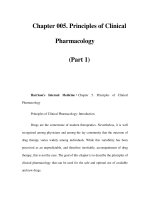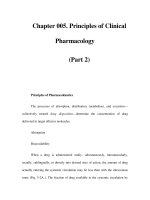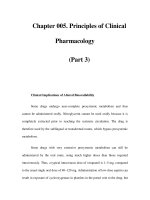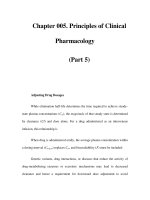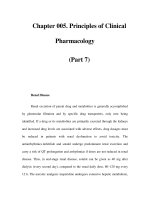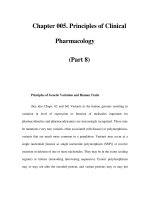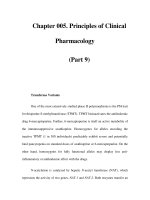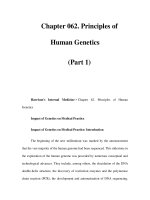Chapter 062. Principles of Human Genetics (Part 24) ppt
Bạn đang xem bản rút gọn của tài liệu. Xem và tải ngay bản đầy đủ của tài liệu tại đây (17.62 KB, 5 trang )
Chapter 062. Principles of
Human Genetics
(Part 24)
Nucleotide Repeat Expansion Disorders
Several diseases are associated with an increase in the number of nucleotide
repeats above a certain threshold (Table 62-6). The repeats are sometimes located
within the coding region of the genes, as in Huntington disease or the X-linked
form of spinal and bulbar muscular atrophy (SBMA, Kennedy syndrome). In other
instances, the repeats probably alter gene regulatory sequences. If an expansion is
present, the DNA fragment is unstable and tends to expand further during cell
division. The length of the nucleotide repeat often correlates with the severity of
the disease. When repeat length increases from one generation to the next, disease
manifestations may worsen or be observed at an earlier age; this phenomenon is
referred to as anticipation. In Huntington disease, for example, there is a
correlation between age of onset and length of the triplet codon expansion (Chap.
360). Anticipation has also been documented in other diseases caused by dynamic
mutations in trinucleotide repeats (Table 62-6). The repeat number may also vary
in a tissue-specific manner. In myotonic dystrophy, the CTG repeat may be tenfold
greater in muscle tissue than in lymphocytes (Chap. 382).
Table 62-6 Selected Trinucleotide Repeat Disorders
Disease Loc
us
Re
peat
Triple
t Length
(Normal/Dis
ease)
Inherit
ance
Gene
Product
X-
chromosomal
spinobulbar
muscular
atrophy (SBMA)
Xq1
1-q12
CA
G
11–
34/40–62
XR Andro
gen receptor
Fragile
X-syndrome
Xq2
7.3
CG
G
6–
50/200–300
XR FMR-
1 protein
(FRAXA)
Fragile
X-syndrome
(FRAXE)
Xq2
8
GC
C
6–
25/>200
XR FMR-
2 protein
Dystrophi
a myotonica
(DM)
19q1
3.2-q13.3
CT
G
5–
30/200–1000
AD,
variable
penetrance
Myot
onin protein
kinase
Huntingt
on disease (HD)
4p16
.3
CA
G
6–
34/37–180
AD Hunti
ngtin
Spinocere
bellar ataxia
type 1 (SCA1)
6p21
.3-21.2
CA
G
6–
39/40–88
AD Ataxi
n 1
Spinocere
bellar ataxia
type 2 (SCA2)
12q2
4.1
CA
G
15–
31/34–400
AD Ataxi
n 2
Spinocere
bellar ataxia
type 3 (SCA3);
Machado Joseph
disease (MD)
14q2
1
CA
G
13–
36/55–86
AD Ataxi
n 3
Spinocere
bellar ataxia
type 6 (SCA6,
CACNAIA)
19p1
3.1-13.2
CA
G
4–
16/20–33
AD
Alpha
1A voltage-
dependent L-
type calcium
channel
Spinocere
bellar ataxia
type 7 (SCA7)
3p21
.1-p12
CA
G
4–
19/37 to
>300
AD Ataxi
n 7
Spinocere
bellar ataxia
type 12
(SCA12)
5q31
CA
G
6–
26/66–78
AD Protei
n
phosphatase
2A
Dentorub
ral
pallidoluysiane
atrophy
(DRPLA)
12p CA
G
7–
23/49–75
AD Atrop
hin 1
Friedreic
h ataxia
(FRDA1)
9q13
-21
GA
A
7–
22/200–900
AR Fratax
in
